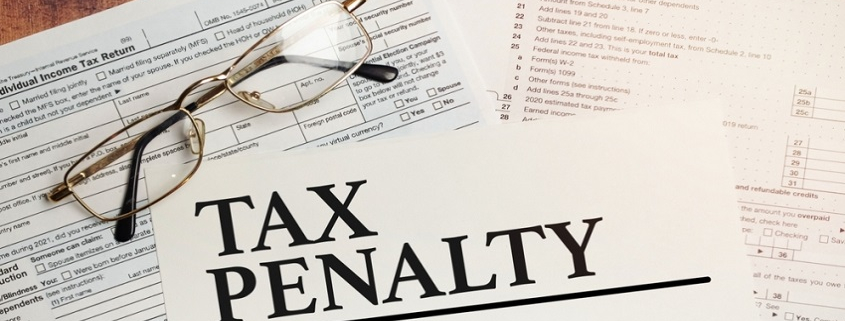IRS Offers Pandemic-Related Relief On Some Penalties To Nearly 5 Million Taxpayers
Some 4.7 million taxpayers nationwide who owe back taxes but haven’t seen a notice in more than a year will be granted relief from some penalties, thanks to a new initiative by the Internal Revenue Service.
The break, which adds up to $1 billion in relief, applies to individuals, businesses and tax-exempt organizations that were not sent automated collection reminder notices during the pandemic. The IRS noted that most of those receiving the penalty relief make less than $400,000 a year.
Nearly 70% of the individual taxpayers receiving penalty relief have income under $100,000 per year, the IRS said. Only those who owed less than $100,000 in back taxes for specific tax years 2020 and 2021 would see such relief.
Taxpayers could save on average about a bit more than $200 per return, thanks to the waiving of a key penalty. This penalty relief is automatic. Eligible taxpayers don’t need to anything.
The IRS is not waiving interest on unpaid taxes, just the failure-to-pay penalty. No relief is being given for failure to file a return. The failure to pay penalty is complicated but amounts to 0.5% of the unpaid taxes for each month or part of a month the tax remains unpaid. The penalty won’t exceed 25% of your unpaid taxes.
Taxpayers who already paid this penalty would be getting a refund, following the new waiver. The IRS will send the first round of such refunds now through January. The IRS will issue a refund or credit the payment toward another outstanding tax liability.
“If a taxpayer does not receive a refund, a special reminder notice may be sent with their updated balance beginning in early 2024,” the IRS said.
Taxpayers with questions on penalty relief can contact the IRS after March 31, 2024.
Go to IRS.gov/penaltyrelief for information on potentially waiving such penalties even if you don’t qualify for the new break. Taxpayers who are not eligible for this new automatic relief have other options, the IRS said, such as applying for relief under the reasonable cause criteria or the First-Time Abate program.
The IRS will restart sending automated collection notices and letters in 2024, marking the end of a pandemic-related pause. Mailings will go out on a staggered basis and gradually resume over several months.
In January, for example, the IRS will begin sending automated collection paperwork to individuals with tax debts prior to tax year 2022. Also in January, the IRS will send automated notices to businesses, tax exempt organizations and estates with tax debts prior to 2023, with exceptions for those with existing debt in multiple years.
Some automated notices already went out in the fall regarding individual returns for tax year 2022 and third quarter 2023 business returns.
Trying To Get Back To Normal After Pandemic Setbacks
All sorts of tax-related havoc took place during the COVID-19 pandemic. Starting in February 2022, for example, the IRS temporarily stopped mailing automated reminders to taxpayers to pay overdue tax bills. These taxpayers had received an initial notice but did not get follow-up notices.
IRS Commissioner Danny Werfel just said in a call with the news media that the IRS had to take extraordinary steps to deal with the extraordinary events associated with the pandemic.
“The pandemic and the disruption it created is unprecedented,” Werfel said.
The IRS suspended follow-up notices to free up resources to deal with other operations.
“These reminders would have normally been issued as a follow up after the initial notice,” the IRS stated.
The reminder notices were suspended, but the failure-to-pay penalty continued to build for taxpayers who did not fully pay their bills after receiving an initial balance due notice.
Now, the IRS said that it is taking steps to waive the failure-to-pay penalties for eligible taxpayers for tax years 2020 and 2021. The IRS estimates that 5 million tax returns — filed by 4.7 million individuals, businesses, trusts, estates and tax-exempt organizations — are eligible for the penalty relief.
The IRS will issue a special reminder letter starting in January to alert taxpayers of their liability, suggest some ways to pay and disclose the amount of penalty relief, if applied. The IRS urges taxpayers who are unable to pay their full balance to visit IRS.gov/payments to make arrangements to resolve their bill.
Some installment agreements and payment plans to pay off a balance over time are available at no cost through the IRS and can help many people. See IRS.gov/payments/online-payment-agreement-application for details on how to apply for a payment plan online.
The relief announced is automatic but applies only to eligible taxpayers with assessed tax under $100,000. These taxpayers were issued an initial balance due notice between Feb. 5, 2022, and before Dec. 7, 2023. The IRS notes the $100,000 limit applies separately to each return and each entity. The failure-to-pay penalty will resume accruing again on April 1, 2024, for taxpayers eligible for relief.
Werfel warned that marketers and promoters can exploit the news, and resumption of notices, to offer deals that are too good to be true when a taxpayer is unable to pay back taxes. Taxpayers need to move cautiously if they hear of promotions to wipe out their tax debt.
“Some unscrupulous promoters mislead taxpayers into thinking they can magically get rid of a tax debt,” the IRS warns.
A legitimate IRS program can help but there are specific requirements for people to qualify. The IRS warned that people who are desperate for help can make a costly mistake, paying hefty fees, if they clearly don’t qualify for the IRS program.
Taxpayers are encouraged to do their research before engaging with an aggressive promoter to resolve a tax debt.
Source: Detroit Free Press



